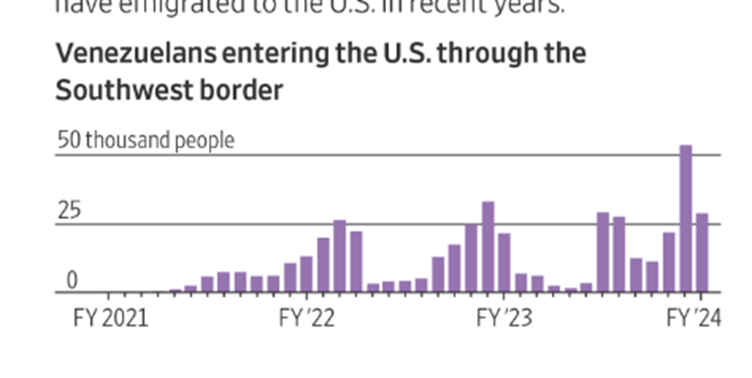Immigrants in New York City: Waiting on hope.
Photo source: Andrea Renault, Zuma Press; The Wall Street Journal
More than 160,000 migrants have come to New York since spring 2022. Almost half are under city care, such as tent camps on Randall’s Island. Republican Governor Abbott of Texas is busing or flying migrants to cities with Democratic mayors, especially New York, Chicago, and Denver. Conservatives complain that the country cannot afford so many migrants. They may not be able to work for months. Boundless, which aids migrants looking for work, estimates that the Citizenship and Immigration Services takes 6.7 months to process an application for a work permit. Meanwhile, migrants require food and shelter.
The problem may be that many migrants have no plans, so they take a long time to qualify for and find work. But the US has a shortage of unskilled labor and needs migrants in areas with that shortage. The U.S. unemployment rate is 3.7%, about as low as it has been for 20 years. In Maryland, North Dakota, and South Dakota, the unemployment rate in November was no higher than 2%.
Why couldn't migrants arriving in Mexico take a day to make a plan, target a destination, learn how to apply for a work permit, and plan to learn English and other skills? American intake officers would help them draw up their plans. Upon approval of the plans, they would be admitted to the United States, subject to immigration laws. Indeed, in Chicago, one pilot program processes applications for work permits in one to four weeks.
Republicans argue that the size of the influx of immigrants into the US is proof that President Joe Biden’s border policy has failed. Build a wall, they say. But immigrants may come knocking, almost regardless of what Washington does. Those with ambition, or with worries about their families, may do almost anything to escape failed nations like Venezuela, where more than one of every four residents has left the country. The number of Venezuelans at the Mexican border has risen sharply in recent months; see the figure below. Even a wall may fail to stop such motivated migrants.
Source: The Wall Street Journal
Here’s a simple if crude test of the idea that lax border controls create migration: Look at the correlation between the number of arrests in one year and in the previous year. A negative and significant correlation is evidence for the idea. To put it another way, a stricter border policy will not reduce immigration if we observe that arrests are rising over time. Of course, arrests may rise partly because of stricter control policies. But regardless of why the arrests occur, an increase in them over time is evidence that migrants pay no attention to them. This test assumes that the population of likely migrants is the same across all years studied, so that we can look at the number of arrests and not at the share of actual immigrants of all likely immigrants, which could be hard to measure.
The figure below shows total enforcement actions for federal fiscal years 2017 through 2024. The fiscal year begins in October. I projected the 2024 figure from the current quarter. Clearly, enforcement actions are rising. The correlation is .83. This is with a seasonal adjustment described in the Notes. Despite former President Donald Trump's jeremiads of a migration flood, arrests fell this winter for the first time since the pandemic, indicating that the number of migrants also fell.
The definition of total enforcement actions changed in 2020. So I recalculated the correlation for 2020 through 2024. It was still a high .73.
Source: The Wall Street Journal
My suggestions and statistics are sketchy. But the point is that immigration is an opportunity for the nation, not a danger. Those determined enough to climb a wall to come, may become productive workers. --Leon Taylor, Baltimore tayloralmaty@gmail.com
Notes
I thank, but do not implicate, Nicholas Baigent, Annabel Benson, Paul Higgins, and Mark Kennet.
Migrant arrests are usually high in the summer and low in the winter (see the figure below for fiscal 2023. On the horizontal axis, 1 corresponds to October, 2 to November, etc. Arrests are lowest in January and highest in May). To annualize arrests for fiscal 2024, I adjusted seasonally the data available, which are for the quarter beginning October 1 and running through December. I calculated the seasonal adjustment as a in the formula aQ = T/4, where Q is the number of arrests in the first quarter of fiscal 2023 (that is, October 1, 2022 through December 31, 2022), and T is the total number of arrests in fiscal 2023. The parameter a was 1.146. In other words, arrests in the first quarter were 15% below the annual average.
References
Joe Barrett, Erin Ailworth, and Alicia A. Caldwell. Surge of Migrants Heading North Has Chicago, New York at ‘Breaking Point’ - WSJ . December 30, 2023.
Boundless.com Form I-765: Application for Employment Authorization, Explained (boundless.com)
U.S. Customs and Border Protection. Southwest Land Border Encounters FY22 | U.S. Customs and Border Protection (cbp.gov)





No comments:
Post a Comment